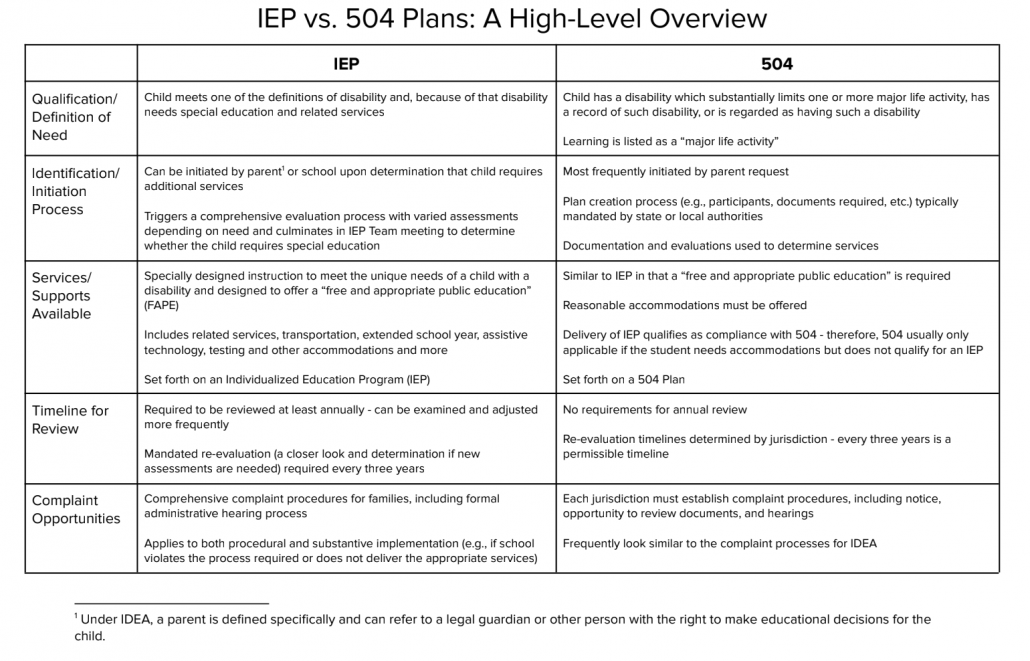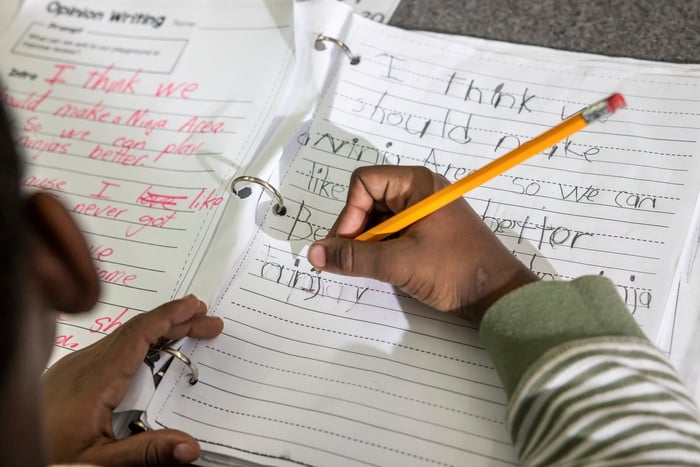What’s the Difference Between an IEP and a 504 Plan?
Tools • 6 min read • Aug 2, 2021 5:30:15 PM • Written by: Sarah Sandelius

What’s the Difference Between an IEP and a 504 Plan?
We’ve heard it over and over: what’s the difference between an IEP and a 504 Plan? Well, wonder no longer! Your answer is here.
Today, it is estimated that one in five public school students has a disability. This includes:
-
Students with disabilities who qualify for services under IDEA (14% of public school students);
-
Students with disabilities who qualify for services under Section 504 (2% of students); and
- Students with disabilities who do not have plans under either of these laws (~4% of students).
IEPs and 504 Plans are the legal documents that set forth the services and supports schools must deliver to qualified students.

Individualized Education Program
A student with a disability is entitled to an Individualized Education Program (IEP) when the student requires specialized instruction and related services in order to receive an educational benefit in school.
While schools have an obligation to identify students in need of special education, parents also have a right to request an evaluation of their child. An IEP is created by a team (which includes teachers, administrators, providers, and the parent(s)) using current performance, assessment data, and other relevant records to determine the student’s specific needs. Unique, annual goals align to services and supports to help the student make progress in class.
The IEP outlines the services a student requires in school, including:
- The instructional placement and classroom supports for a student;
- Accommodations and modifications; and
- Additional services such as counseling, speech, occupational therapy, transportation, extended school year, and assistive technology.

Section 504 Plan
Section 504 of the Rehabilitation Act and Title II of the Americans with Disabilities Act also set forth rights for students with disabilities in public schools, and even go beyond the K-12 context to higher education, such as college or trade schools.
The qualification criteria for a 504 Plan are a little different from the IEP. Instead of requiring a full set of evaluations and assessments, a student is eligible for 504 if the student shows they have a mental or physical impairment that substantially limits their learning. Further, plans are frequently initiated by a student’s family and documentation of the disability is provided by a medical provider or other clinicians.
Provisions are similar to IDEA in that students have a written plan that outlines what additional supports they will receive in school. The main difference with 504 is that there are no annual goals and supports are frequently focused around reasonable classroom and testing accommodations.
Technically, a student with a 504 Plan is not considered enrolled in special education and a school usually does not receive additional funding allocations to comply with 504 Plans.
Main Takeaways
So, what do you really need to remember? Here are the biggest differences:
- An IEP is a more in depth description of services and supports, aligned to annual goals, whereby a 504 Plan is often focused on reasonable accommodations.
- The process for obtaining documents is different – an IEP requires a formal evaluation process and IEP team meeting, while a 504 Plan is typically created according to local rules.
- Both require a school to provide a free and appropriate public education to students with disabilities – all students, even those with disabilities, are entitled to an educational benefit.
Here’s a tool you can use to see the difference between IEPs and 504s at a glance.

Learn more about the difference between an IEP and a 504 plan!
Sarah Sandelius
Our Latest
Related Articles

September 14, 2021 | Tools
The IEP: What Classroom and Specials Teachers REALLY Need to Know
You can maximize the individualized education program. We’ve created an IEP review tool for classroo...

September 27, 2021 | Tools
Classroom Behavior Woes? Try a Communication Roadmap
Learn how to identify and address classroom challenges with our Step-by-Step guide and downloadable ...

August 17, 2023 | Impact
New Case Studies Reveal Practical Strategies to Manage Disruptive Student Behavior
In this post, ABC outlines how it helped educators and leaders at two schools work together to addre...

